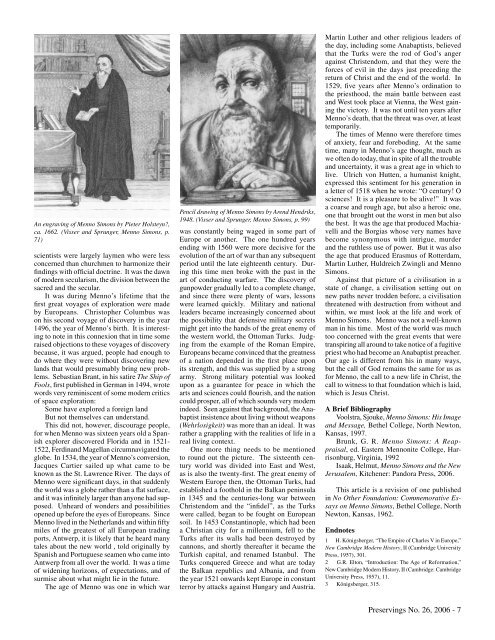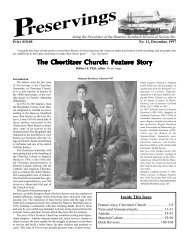Preservings $20 Issue No. 26, 2006 - Home at Plett Foundation
Preservings $20 Issue No. 26, 2006 - Home at Plett Foundation
Preservings $20 Issue No. 26, 2006 - Home at Plett Foundation
Create successful ePaper yourself
Turn your PDF publications into a flip-book with our unique Google optimized e-Paper software.
An engraving of Menno Simons by Pieter Holsteyn?,<br />
ca. 1662. (Visser and Sprunger, Menno Simons, p.<br />
71)<br />
scientists were largely laymen who were less<br />
concerned than churchmen to harmonize their<br />
findings with official doctrine. It was the dawn<br />
of modern secularism, the division between the<br />
sacred and the secular.<br />
It was during Menno’s lifetime th<strong>at</strong> the<br />
first gre<strong>at</strong> voyages of explor<strong>at</strong>ion were made<br />
by Europeans. Christopher Columbus was<br />
on his second voyage of discovery in the year<br />
1496, the year of Menno’s birth. It is interesting<br />
to note in this connexion th<strong>at</strong> in time some<br />
raised objections to these voyages of discovery<br />
because, it was argued, people had enough to<br />
do where they were without discovering new<br />
lands th<strong>at</strong> would presumably bring new problems.<br />
Sebastian Brant, in his s<strong>at</strong>ire The Ship of<br />
Fools, first published in German in 1494, wrote<br />
words very reminiscent of some modern critics<br />
of space explor<strong>at</strong>ion:<br />
Some have explored a foreign land<br />
But not themselves can understand.<br />
This did not, however, discourage people,<br />
for when Menno was sixteen years old a Spanish<br />
explorer discovered Florida and in 1521-<br />
1522, Ferdinand Magellan circumnavig<strong>at</strong>ed the<br />
globe. In 1534, the year of Menno’s conversion,<br />
Jacques Cartier sailed up wh<strong>at</strong> came to be<br />
known as the St. Lawrence River. The days of<br />
Menno were significant days, in th<strong>at</strong> suddenly<br />
the world was a globe r<strong>at</strong>her than a fl<strong>at</strong> surface,<br />
and it was infinitely larger than anyone had supposed.<br />
Unheard of wonders and possibilities<br />
opened up before the eyes of Europeans. Since<br />
Menno lived in the Netherlands and within fifty<br />
miles of the gre<strong>at</strong>est of all European trading<br />
ports, Antwerp, it is likely th<strong>at</strong> he heard many<br />
tales about the new world , told originally by<br />
Spanish and Portuguese seamen who came into<br />
Antwerp from all over the world. It was a time<br />
of widening horizons, of expect<strong>at</strong>ions, and of<br />
surmise about wh<strong>at</strong> might lie in the future.<br />
The age of Menno was one in which war<br />
Pencil drawing of Menno Simons by Arend Hendriks,<br />
1948. (Visser and Sprunger, Menno Simons, p. 99)<br />
was constantly being waged in some part of<br />
Europe or another. The one hundred years<br />
ending with 1560 were more decisive for the<br />
evolution of the art of war than any subsequent<br />
period until the l<strong>at</strong>e eighteenth century. During<br />
this time men broke with the past in the<br />
art of conducting warfare. The discovery of<br />
gunpowder gradually led to a complete change,<br />
and since there were plenty of wars, lessons<br />
were learned quickly. Military and n<strong>at</strong>ional<br />
leaders became increasingly concerned about<br />
the possibility th<strong>at</strong> defensive military secrets<br />
might get into the hands of the gre<strong>at</strong> enemy of<br />
the western world, the Ottoman Turks. Judging<br />
from the example of the Roman Empire,<br />
Europeans became convinced th<strong>at</strong> the gre<strong>at</strong>ness<br />
of a n<strong>at</strong>ion depended in the first place upon<br />
its strength, and this was supplied by a strong<br />
army. Strong military potential was looked<br />
upon as a guarantee for peace in which the<br />
arts and sciences could flourish, and the n<strong>at</strong>ion<br />
could prosper, all of which sounds very modern<br />
indeed. Seen against th<strong>at</strong> background, the Anabaptist<br />
insistence about living without weapons<br />
(Wehrlosigkeit) was more than an ideal. It was<br />
r<strong>at</strong>her a grappling with the realities of life in a<br />
real living context.<br />
One more thing needs to be mentioned<br />
to round out the picture. The sixteenth century<br />
world was divided into East and West,<br />
as is also the twenty-first. The gre<strong>at</strong> enemy of<br />
Western Europe then, the Ottoman Turks, had<br />
established a foothold in the Balkan peninsula<br />
in 1345 and the centuries-long war between<br />
Christendom and the “infidel”, as the Turks<br />
were called, began to be fought on European<br />
soil. In 1453 Constantinople, which had been<br />
a Christian city for a millennium, fell to the<br />
Turks after its walls had been destroyed by<br />
cannons, and shortly thereafter it became the<br />
Turkish capital, and renamed Istanbul. The<br />
Turks conquered Greece and wh<strong>at</strong> are today<br />
the Balkan republics and Albania, and from<br />
the year 1521 onwards kept Europe in constant<br />
terror by <strong>at</strong>tacks against Hungary and Austria.<br />
Martin Luther and other religious leaders of<br />
the day, including some Anabaptists, believed<br />
th<strong>at</strong> the Turks were the rod of God’s anger<br />
against Christendom, and th<strong>at</strong> they were the<br />
forces of evil in the days just preceding the<br />
return of Christ and the end of the world. In<br />
1529, five years after Menno’s ordin<strong>at</strong>ion to<br />
the priesthood, the main b<strong>at</strong>tle between east<br />
and West took place <strong>at</strong> Vienna, the West gaining<br />
the victory. It was not until ten years after<br />
Menno’s de<strong>at</strong>h, th<strong>at</strong> the thre<strong>at</strong> was over, <strong>at</strong> least<br />
temporarily.<br />
The times of Menno were therefore times<br />
of anxiety, fear and foreboding. At the same<br />
time, many in Menno’s age thought, much as<br />
we often do today, th<strong>at</strong> in spite of all the trouble<br />
and uncertainty, it was a gre<strong>at</strong> age in which to<br />
live. Ulrich von Hutten, a humanist knight,<br />
expressed this sentiment for his gener<strong>at</strong>ion in<br />
a letter of 1518 when he wrote: “O century! O<br />
sciences! It is a pleasure to be alive!” It was<br />
a coarse and rough age, but also a heroic one,<br />
one th<strong>at</strong> brought out the worst in men but also<br />
the best. It was the age th<strong>at</strong> produced Machiavelli<br />
and the Borgias whose very names have<br />
become synonymous with intrigue, murder<br />
and the ruthless use of power. But it was also<br />
the age th<strong>at</strong> produced Erasmus of Rotterdam,<br />
Martin Luther, Huldreich Zwingli and Menno<br />
Simons.<br />
Against th<strong>at</strong> picture of a civilis<strong>at</strong>ion in a<br />
st<strong>at</strong>e of change, a civilis<strong>at</strong>ion setting out on<br />
new p<strong>at</strong>hs never trodden before, a civilis<strong>at</strong>ion<br />
thre<strong>at</strong>ened with destruction from without and<br />
within, we must look <strong>at</strong> the life and work of<br />
Menno Simons. Menno was not a well-known<br />
man in his time. Most of the world was much<br />
too concerned with the gre<strong>at</strong> events th<strong>at</strong> were<br />
transpiring all around to take notice of a fugitive<br />
priest who had become an Anabaptist preacher.<br />
Our age is different from his in many ways,<br />
but the call of God remains the same for us as<br />
for Menno, the call to a new life in Christ, the<br />
call to witness to th<strong>at</strong> found<strong>at</strong>ion which is laid,<br />
which is Jesus Christ.<br />
A Brief Bibliography<br />
Voolstra, Sjouke, Menno Simons: His Image<br />
and Message, Bethel College, <strong>No</strong>rth Newton,<br />
Kansas, 1997.<br />
Brunk, G. R. Menno Simons: A Reappraisal,<br />
ed. Eastern Mennonite College, Harrisonburg,<br />
Virginia, 1992<br />
Isaak, Helmut, Menno Simons and the New<br />
Jerusalem, Kitchener: Pandora Press, <strong>2006</strong>.<br />
This article is a revision of one published<br />
in <strong>No</strong> Other Found<strong>at</strong>ion: Commemor<strong>at</strong>ive Essays<br />
on Menno Simons, Bethel College, <strong>No</strong>rth<br />
Newton, Kansas, 1962.<br />
Endnotes<br />
1 H. Königsberger, “The Empire of Charles V in Europe,”<br />
New Cambridge Modern History, II (Cambridge University<br />
Press, 1957), 301.<br />
2 G.R. Elton, “Introduction: The Age of Reform<strong>at</strong>ion,”<br />
New Cambridge Modern History, II (Cambridge: Cambridge<br />
University Press, 1957), 11.<br />
3 Königsberger, 315.<br />
<strong>Preservings</strong> <strong>No</strong>. <strong>26</strong>, <strong>2006</strong> -
















